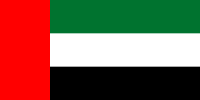| Emirati Arabic | |
|---|---|
| اللهجة الإماراتية | |
 | |
| Native to | United Arab Emirates |
| Region | Eastern Arabia |
| Ethnicity | Emirati Arabs |
Native speakers | 3.7 million (2020)[1] |
| Dialects |
|
| Arabic alphabet, Arabic chat alphabet | |
| Language codes | |
| ISO 639-3 | afb |
 | |
Emirati Arabic (Arabic: اللهجة الإماراتية, romanized: al-Lahjah al-Imārātīyah) refers to a group of Arabic dialectal varieties spoken by the Emiratis native to the United Arab Emirates that share core characteristics with specific phonological, lexical, and morphosyntactic features and a certain degree of intra-dialectal variation, which is mostly geographically defined. It incorporates grammatical properties of smaller varieties within the UAE, generally of tribal nature, which can be roughly divided into a couple of broader sub-varieties: the first spoken in the Northern Emirates of Dubai, Sharjah, Ajman, Umm al-Quwain, and the western part of Ras al-Khaimah; the second in the eastern part of the country, mainly in Fujeirah, Dibba, Khor Fakkan, Hatta, Kalba, and the eastern part of Ras al-Khaimah; the third in Abu Dhabi including the oasis city of Al Ain, the dialect is also seen in the Omani region of Al-Buraimi.[13] Emirati Arabic varieties can also be distinguished based on environmental factors, including variations associated with Bedouin communities, coastal, agricultural, and mountainous regions.[14]
Additionally, a pidgin form of Emirati Arabic exists, predominantly utilized by blue-collar workers in the UAE. This linguistic variant, which is closely related to other variants of Gulf Pidgin Arabic, amalgamates elements of Emirati Arabic with other languages like English, Farsi, Hindi, Urdu, and Tagalog. Serving as a simplified means of communication, Emirati Pidgin Arabic facilitates basic interactions in workplaces, construction sites, and similar environments where multilingual communication is necessary.[15][16]
Speakers of Emirati Arabic identify themselves as speakers of a distinct variety (as compared with other neighbouring dialects such as Qatari or Kuwaiti Arabic), based on several phonological, morphological, and syntactic properties that distinguish Emirati Arabic from other Gulf Arabic varieties.[13]
Emirati Arabic dialects are believed to have evolved from the linguistic variations spoken by ancient pre-Islamic Arabian tribes in the region, particularly the Azd, Qays, and Tamim, as noted by Emirati linguist and historian, Ahmed Obaid.[17]
- ^ Emirati Arabic at Ethnologue (27th ed., 2024)

- ^ "اللّهجة الإماراتية".
- ^ "كم عدد اللهجات في الامارات؟".
- ^ "اللّهجة الإماراتية".
- ^ "اللّهجة الإماراتية".
- ^ "اللّهجة الإماراتية".
- ^ "اللّهجة الإماراتية".
- ^ "اللّهجة الإماراتية".
- ^ "اللّهجة الإماراتية".
- ^ "اللّهجة الإماراتية".
- ^ "اللّهجة الإماراتية".
- ^ Altakhaineh, Abdel Rahman Mitib; Al-Namer, Abdul-Salam; Alnamer, Sulafah (2022). "Degemination in Emirati Pidgin Arabic: A Sociolinguistic Perspective". Languages. 7: 8. doi:10.3390/languages7010008.
- ^ a b Leung, Tommi Tsz-Cheung; Ntelitheos, Dimitrios; Kaabi, Meera Al (2020-12-29). Emirati Arabic: A Comprehensive Grammar. Routledge. ISBN 978-1-000-30055-0.
- ^ للأخبار, مركز الاتحاد (2016-05-19). "اللهجات الإماراتية فصيحة وهجينها قليل". مركز الاتحاد للأخبار (in Arabic). Retrieved 2024-03-14.
- ^ Altakhaineh, Abdel Rahman Mitib; Al-Namer, Abdul-Salam; Alnamer, Sulafah (5 January 2022). "Degemination in Emirati Pidgin Arabic: A Sociolinguistic Perspective". Languages. 7 (1): 8. doi:10.3390/languages7010008. ISSN 2226-471X.
- ^ Naylor, Hugh (2008-10-09). "The word on the street - same-same, but different". The National. Retrieved 2024-03-14.
- ^ البيان, دبي- (2019-09-10). "«اللهجات الإماراتية».. بيئات وجذور". www.albayan.ae (in Arabic). Retrieved 2024-03-14.